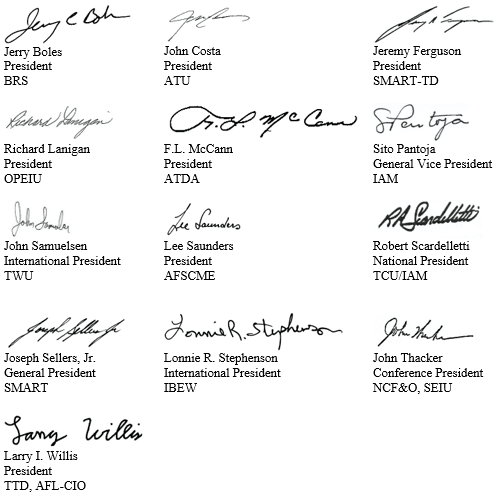
The most essential factor in the restoration of passenger transportation is the promise that travel will be safe and that COVID-19 risks have been properly mitigated for passengers and frontline transportation workers. We wholeheartedly applauded President Biden’s common-sense Executive Order on Promoting COVID-19 Safety in Domestic and International Travel, which came during one of the darkest stages of the pandemic. At a time when new daily COVID-19 cases averaged over 150,000 and the vaccines were not available to the vast majority of Americans, this order mandated the wearing of masks on many forms of transportation for both workers and passengers. While enforcement has proven to be challenging at many transportation operations, this standard must remain in place until COVID-19 has been defeated.
Perhaps more important is the ongoing need to complete the most ambitious mass-vaccination campaign in world history. While mask usage and current levels of inoculation have begun to bear fruit in terms of passenger volume, many more vaccinations are required before travel across modes returns to pre-COVID levels. In this regard, there are three tenets of vaccination efforts that must be realized.
First, transportation workers, including flight crews, conductors, drivers and other at-risk employees must have access to vaccines. As of April 21, 2021, all states are allowing any adult to receive a vaccine, but in many cases rollouts have been uneven, and challenges have persisted particularly for employees who are frequently away from their place of residence where they qualify for vaccines. States and employers should continue to focus on making sure that the workers who put their lives on the line each day to keep intercity transportation running have the ability to receive vaccines, and should pursue remedies where challenges in doing so have arisen.
Secondly, to further stimulate demand for domestic travel, it is essential that efforts to vaccinate the population broadly continue unabated. We are encouraged by the rates at which Americans are currently being vaccinated and we are optimistic for the sustained upward trajectory required for a return to normalcy.
Finally, such a return will also require international efforts. For both the safety of flight crews who travel through foreign airports and cities, and for renewed demand for international business and tourist travel, conquering the virus globally is also essential. This effort must not be neglected.
Over the last year, Congress recognized the crisis looming for intercity passenger transportation and its workforce, implementing a series of programs and emergency spending intended to keep workers on payroll and connected to critical benefits like healthcare, and to prevent against an economic collapse triggered by a wave of bankruptcies of major U.S. companies. These measures have been a vital lifeline and their continuing implementation will be instrumental in the return of intercity passenger service.
For airlines and airline contractors, the Payroll Support Program (PSP) has been extremely successful in protecting employees from the brunt of the rapid drop in air travel due to the pandemic, and hundreds of thousands of employees have continued to be able to pay their bills and seek medical care due to the program. Treasury should continue to disperse funds appropriated for the PSP, including through the American Rescue Plan, and continue to observe the firewall between government assistance and employee collective bargaining agreements included in the CARES Act and the Consolidated Appropriations Act, 2021.
Amtrak has also received substantial funding through COVID legislation, which will ensure that the rail carrier and its workforce are prepared to respond to increased demand as the pandemic abates. The American Rescue Plan required Amtrak to restore its long-distance service and recall all furloughed employees within 90 days — smartly ensuring that relief was directed to employees and service maintenance. The restoration of long-distance service, reduced to three times a week from pre-COVID daily service on most routes revitalizes critical connections between urban hubs and rural communities, and promotes the future of these lines by underscoring their reliability and consistent presence to the riders who rely on them. The recall of approximately 1,200 furloughed employees and prohibitions on further furloughs will not only benefit workers on the unemployment lines, but is required to meet the service demands that we hope and expect to see shortly. Amtrak must act to restore its service and employees in an expeditious manner, and should seek to comply with statutory requirements well in advance of Congress’ deadlines.
In the second COVID relief bill, H.R. 133, Congress wisely included the CERTS Act, which sought to provide funding to transportation entities that had previously received aid, including school bus contractors, non-transit ferry services and motorcoach operators. Despite its passage on December 27 of last year, the Trump administration Treasury took no actions to make the grants available to entities that badly needed them. We call on the Treasury to dispense these grants as soon as possible. This is particularly necessary given the dire straits the motorcoach industry currently finds itself in. Motorcoach operators previously provided over 500 million passenger trips per year, serving both urban and rural travelers. However, given how many companies have already closed their doors, or are on the precipice of doing so, if aid is not promptly dispersed, the post-COVID economy may find itself deeply lacking in critical intercity passenger bus service.
While Congress correctly did not provide direct aid to cruise line operators who have chosen to flag their vessels in foreign countries, the resumption of cruise line service is important for the recovery of cruise port cities like Miami, and the thousands of longshore workers who prepare these vessels for voyage. We call on the CDC to only revise its No-Sail Order when it is deemed safe to do so. We also urge the CDC to consider the health and safety of longshore workers in any future guidance on the resumption of cruise line travel.
Finally, one of the most impactful actions the federal government can take to restore intercity passenger transportation is passing legislation that makes bold investments in our nation’s infrastructure, which this body has consistently called for. There is a real opportunity right now for the federal government to make the types of generational investments into our transportation systems that will not only help us recover economically and restore passenger transportation to pre-COVID levels, but also to build a system that can once again be the envy of the world. We can modernize and upgrade across every mode, and expand service throughout the country, especially to communities that have historically been underserved. In doing so we can rebuild our economy, create jobs and support the millions of transportation workers who keep America moving.
###
The Transportation Trades Department, AFL-CIO, (TTD) is a coalition of 33 member unions, including the SMART Transportation Division, that provides a bold voice for workers in every mode of transportation – both in the private and public sector – and is devoted to protecting middle-class jobs, expanding collective bargaining, and ensuring modern, safe, and secure transportation operations and infrastructure.


 The Coronavirus Aid, Relief, and Economic Security Act, or CARES Act, signed into law March 27, boosts unemployment and sickness benefits for railroad workers impacted by the pandemic.
The Coronavirus Aid, Relief, and Economic Security Act, or CARES Act, signed into law March 27, boosts unemployment and sickness benefits for railroad workers impacted by the pandemic.